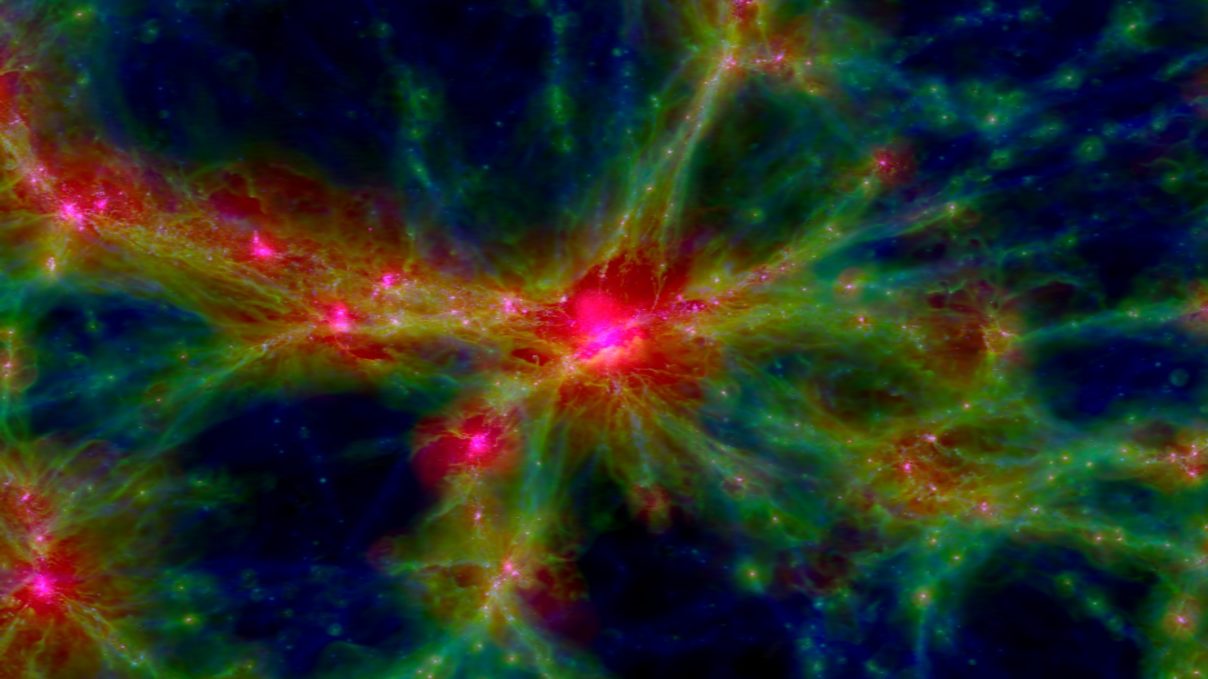Simulating the Universe: The Eagle Project
Simulating the Universe: The Eagle Project
The ultimate goal of our simulations is to generate a realistic universe inside the computer. The EAGLE project is a world leading simulation that incorporates all the processes of galaxy formation including the formation of stars, feedback and metal enrichment from supernovae as well as accretion onto, and feedback from, black holes. A key feature of the EAGLE project is that the simulation matches most of the observed properties of our universe extremely well. The project is playing a key role in allowing us to understand how galaxies form and evolve, and in answering key questions about the most critical processes that shape the Universe around us.
Read more about Galaxy Formation Simulations and other research at Durham University’s Institute for Computational Cosmology.
The image at the top was selected to appear in the Royal Photographic Society’s exhibition of scientific images. I have put together this description of the image….
Looking out into the universe with even the most advanced telescope, we are acutely aware of the stars and galaxies that they make up. But these only represent a tiny fraction of the material in the Universe. Most of the “light” generated by matter in the universe is invisible, hidden by a cruel trick of the electromagnetic spectrum. This image, generated by the magic of computer simulation, shows our universe as it would appear in the extreme UltraViolet if only this light were able to reach us.
A light ray takes 130 million to cross the image. On this scale galaxies are pin-pricks of optical light, barely visible as pink dots inside some of the largest structures. Instead, what we see is the diffuse gas that pervades the universe. The colours of the image distinguish gas at different temperatures. Red for the hottest gas, green for intermediate temperatures and blue for the coolest gas in the simulation. The image is generated from a computer simulation that tracks all the processes of the real universe in detail. Great care has been taken to ensure that the simulation match the true Universe in as much detail as possible.
Cool blue filaments appear as gas is pulled together by gravity. As it collapses, stars are form in tiny galaxies, but a few of the young stars explode in spectacular supernovae. The blast rips material out of the nascent galaxies and it is seen as green in the image. The filamentary structures become diffuse, complex structures that stand out in the image. Within these filaments larger galaxies form like rubies on a necklace. As the galaxies grow in size, black hole are created by the unstoppable force of gravity. This heats material even higher temperatures creating the largest red haloes. These are surrounded by intense out flows of hot gas. In places the out flow overcomes the confinement of gravity, ripping the structure apart. The prominent red halo of gas at the center is a large cluster of galaxies, gas here is heated to temperatures 10,000 times greater than the surface of the sun. Gas here is so hot that star formation is impossible.
The image illustrates the complex interplay of the gravity that collects the gas into ever larger structures and the violent outflows generated as black holes and galaxies form. This interplay shapes the universe we live in, holding galaxies together yet spreading the chemical elements needed for life widely through the universe.
The EAGLE project aims to reproduce the properties of the observed universe with in a computer simulation. The problem is challenging because of the great range of structures that need to modelled correctly, from the details of star formation to the outflow of gas and the collapse of gravitational structure on the largest scales of the universe. This image was generated using one of the latest computer simulations. It shows the universe at the present-day, but in the computer it is simple to generate images of the Universe at earlier times, allowing us to understand the origins of galaxies like our own Milky Way.

